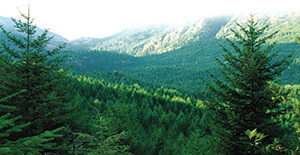Build Green with Sustainable Plywood and OSB Panels
Quick Facts:
- 27 percent more timber is grown than harvested from our managed forests every year. View our list of Forest Management Certification by manufacturer.
- Wood product sourcing and production consume far less energy compared to metal and petroleum based products, leaving a significantly smaller carbon footprint on generations to come.
- Young, growing, vibrant forests are the largest carbon sink on earth: CO2 absorption by U.S. forests has increased by 25 percent since 1990.
- Wood is a renewable, recyclable, biodegradable resource that is easily manufactured into a variety of viable products – products that reduce waste by decreasing disposal costs and product damage.
Sustainably Managed Forests
Today’s sustainably managed North American forests comply with one or more certification agencies responsible for verifying proper forestry practices. These practices include following applicable laws, protecting wildlife, providing habitat buffers and ensuring waste reduction and reuse. View the forest management certification status of select APA performance panel manufacturing members.
Five Facts About Wood
 Through advancements in forestry management, efficiencies in manufacturing and ongoing research, North American wood products are a resource that we can rely upon for thousands of years to come. Here are five facts about wood:
Through advancements in forestry management, efficiencies in manufacturing and ongoing research, North American wood products are a resource that we can rely upon for thousands of years to come. Here are five facts about wood:
North American forests are a source of beauty, recreation and natural, renewable wood products. Forests fully cover one-third of the United States’ and one-half of Canada’s land mass and, through the efforts of the forest products industry, our forestland continues to expand.
American landowners plant more than two billion trees every year. In addition, millions of trees seed naturally. The forest products industry, which comprises about 15 percent of forestland ownership, is responsible for 41 percent of replanted forest acreage. That works out to more than one billion trees a year, or about three million trees planted every day. In Canada, all forests harvested on public lands must be regenerated as part of sustainable forest management. In the last decade, the annual harvest has affected an average of less than 0.3% of the total forest area.
The most recent USDA Forest Service data confirms that United States forestland is roughly as abundant today as it was 100 years ago. The Forest Service’s Resource Planning Act 2007 (RPA data) reveals both state and regional increases in forestland across the country. Among the key findings in the report are:
- There are 766 million acres of forestland in the U.S. today, bout the same as 1907.
- 11 states had increases in forestland of over 25 percent over the last century, and nine had
- Overall, forestland in the northern U.S. has increased by almost 30 percent.
- For more information, visit the USDA Forest Service website.
A 2004 Consortium for Research on Renewable Industrial Materials (CORRIM) study gave scientific validation to the strength of wood as a green building product. Using sophisticated life cycle assessment tools, CORRIM's scientists measured building products’ environmental footprint from cradle to grave.
CORRIM found that wood was better for the environment than steel or concrete when accounting for embodied energy, global warming potential, air and water emissions and solid waste production. For the complete details of the report, visit www.corrim.org.
Processing wood into usable products is highly energy efficient. Wood products make up 47 percent of all industrial raw materials manufactured in the United States, yet consume only 4 percent of the energy needed to manufacture all industrial raw materials, according to a 1987 study.
Compared to wood, it takes five times more energy to produce the same amount of cement, 14 times more for glass, 24 times more for steel and 40 times more for aluminum.
Waste utilization and bioenergy go hand in hand. Over one half of the energy needed for wood production comes from tree bark, sawdust and other natural by-products. The U.S. and Canadian wood products industries are leaders in bioenergy use - the U.S. wood products industry alone accounts for 60 percent of the nation’s bioenergy production and use!
Derived entirely from solar energy, our wood fiber resource is a keystone in reducing global warming. Our abundant forests mitigate climate change by absorbing carbon from the atmosphere and storing it in trees, soil and biomass.
Vibrant growing trees absorb more carbon dioxide than older mature trees, and North American forest landowners work to support this efficient carbon storing process by planting two billion trees every year. For every ton of wood grown, a young forest produces 1.07 tons of oxygen and absorbs 1.47 tons of carbon dioxide.
In fact, wood’s net carbon emissions are below zero. The CO2 absorbed by growing forests and stored in trees and wood products offsets the energy required to harvest, process, transport and maintain those products over time. And quality, durable products made from wood continue to store the carbon for generations to come.
Wood is good. Engineered wood is even better.
Better engineering makes engineered wood stronger, more durable, and better for the environment. Plywood and OSB are considered the original engineered wood products. Glulam and structural composite lumber are other common engineered wood products. In designing these products, scientists use the strongest wood species where the acting forces are greatest. This means less wood fiber is needed to provide the necessary strength.
For more information
Additional articles and resources regarding wood products and the environment:
The following publications from APA – The Engineered Wood Association provide more information: